© Copyright – 2010-2023 : All Rights Reserved. Sitemap
Power Distribution Unit PDU, rack mount PDU, PDU data center, Smart PDu, intelligent PDU
Power Distribution Unit PDU, rack mount PDU, PDU data center, Smart PDu, intelligent PDU
DTI-CX 2025 Digital Transformation Indonesia Conference, DATE:6-7 AUG.2025, Booth No.: C21
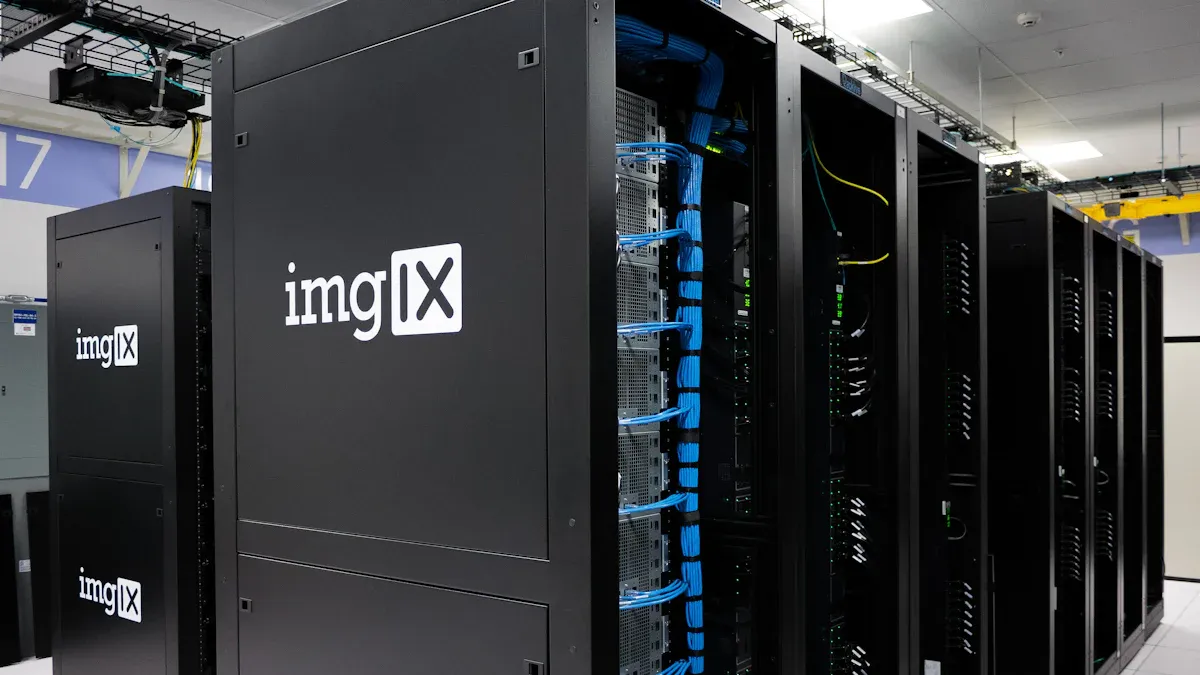
Choosing the right vertical rack PDU helps you achieve reliable power distribution in your data center or server rack. You want to avoid downtime—52% of power outages in data centers link back to issues with PDU selection or maintenance. When you select a vertical rack PDU, pay attention to space efficiency, cable management, and outlet types. Look for the correct voltage, redundancy, and advanced features that match your distribution needs. By checking these factors, you support safe and efficient vertical PDU use in every server rack.
When you select a vertical rack PDU, you need to check several important factors to ensure safe and efficient power distribution. Start by confirming the voltage and phase that match your data center’s infrastructure. Calculate the total power load for your rack by adding up the wattage of all devices. This step helps you avoid overloading the power distribution unit.
Next, look at the number and type of outlets. Make sure the PDU has enough C13, C19, or other outlet types for your equipment. Choose the right input plug type, such as NEMA or IEC, to fit your power source. Decide if you need a basic, metered, or switched PDU. Metered and switched models offer real-time monitoring and remote control, which can help you manage your rack power distribution unit more effectively.
Check the power cord length to ensure it reaches your power source without stretching. Look for surge protection and circuit breakers to protect your equipment from voltage spikes. Make sure the PDU fits your rack’s space and allows for proper airflow. Consider advanced features like remote monitoring, environmental sensors, and color-coded outlets for easier management.
Tip: Always plan for future growth. Choose a power distribution unit with extra capacity and outlets to support new devices as your needs expand.
Many people make mistakes when choosing a vertical rack PDU. Avoid these common errors to keep your distribution reliable:
By following this checklist, you can avoid costly mistakes and ensure your power distribution unit supports safe, efficient, and scalable distribution in your data center.
Understanding your center’s power needs is the first step to smart power distribution. You want to make sure your vertical rack pdu can handle the total consumption of all devices in your server rack. This process helps you avoid overloads and keeps your data safe.
Start by listing every device in your server rack. Look at the power supply rating for each one. You can find this information on the device label or in the manual. Multiply the amperage by the voltage to get the wattage for each device. For example, if a device uses 8 amps and 208 volts, the consumption is 1,664 watts. Add up the wattage of all devices to get the total power draw for your rack.
You should also consider other sources of consumption in your center. Cooling systems often use up to half of the total power. Lighting, security, and backup systems also add to the load. Always include these when you calculate the total consumption for your center.
Tip: Plan for future growth. Choose a power distribution unit with extra capacity so you can add more devices later.
Here is a step-by-step way to calculate your total power load:
This method ensures your center’s power distribution unit supports all current and future devices.
You need to decide between a single-phase and a three-phase vertical rack pdu. Each type has different benefits for your center. The choice affects how much power you can deliver and how you manage distribution.
Here is a comparison to help you choose:
| Aspect | Three-Phase Vertical Rack PDU | Single-Phase Vertical Rack PDU |
|---|---|---|
| Power Capacity | Higher power capacity; supports more power per rack | Lower power capacity; needs more units for same power |
| Voltage Support | Can support both 120V and 208V devices | Usually supports only one voltage level |
| Circuit Breakers | More circuit breakers; fewer lost outlets if one trips | Fewer circuit breakers; more outlets lost if one trips |
| Number of Cords | Fewer cords; saves rack space | More cords; increases clutter |
| Cord Size and Weight | Thicker, heavier cord but fewer needed | Thinner cords but more cables needed |
| Cost | Higher initial cost | Lower initial cost |
| Installation Complexity | Fewer cords and hardware; easier setup | More cords and units; more complex |
| Resilience | More resilient; less impact from breaker trips | Less resilient |
Three-phase PDUs give your center higher power density and better efficiency. You use fewer cables, which makes installation easier and reduces clutter. You also get more resilience because multiple circuit breakers protect your data. Single-phase PDUs cost less at first and are simpler, but you need more hardware and cables for the same power. Think about your center’s size, the number of devices, and your future plans before you choose.
You must check the voltage and input cord compatibility for your power distribution unit. This step ensures safe and reliable distribution in your center. First, determine the voltage your center uses. Many centers use 120V or 208V, but some use other levels. Match the PDU’s input and output voltage to your center’s supply.
Next, look at the input cord. Make sure the plug type fits your power source. Some centers use NEMA plugs, while others use IEC types. The cord length should reach your power source without stretching or creating hazards. Always check both input and output compatibility before you install the PDU.
Note: When you determine pdu input phase, you make sure the PDU matches your center’s power system. Always determine pdu input and output before you buy or install.
By following these steps, you make sure your center’s power distribution unit supports all devices, keeps your data safe, and allows for future growth. Careful planning of consumption, input and output, and distribution helps your center run smoothly.
When you choose the right type of PDU, you make sure your data center or server rack gets the power it needs. Each type of vertical rack pdu offers different features. You should match your choice to your power distribution and monitoring needs.
A basic PDU works like a power strip for your server rack. You use it to distribute power to several devices at once. This type does not offer monitoring or remote control. You often find basic PDUs in smaller setups or places where you do not need advanced features. They give you a simple and cost-effective way to power your equipment.
Basic PDUs convert one or two power inputs into many outputs. You can connect up to eight devices in most cases. You get reliable power for your servers, switches, or storage devices. You do not get energy tracking or alerts, but you do get steady power delivery. If you want a straightforward solution, a basic PDU fits your needs.
Tip: Use basic PDUs when you want a low-cost option for simple power distribution. They work well in small server rooms or for non-critical equipment.
A metered PDU gives you more control over your power use. You see real-time data about voltage, current, and power factor on a local display. This helps you avoid overloads and balance your power load. You can spot problems before they cause downtime.
Monitored PDUs take things further. You get all the features of a metered PDU, plus remote network monitoring. You can check power usage from anywhere using a secure web interface. You receive automatic alerts if power use goes above your set limits. This protects your equipment and helps you plan for future needs.
Here is a quick comparison:
| Feature | Basic PDUs | Metered PDUs |
|---|---|---|
| Monitoring | No real-time monitoring | Real-time monitoring with built-in meters |
| Control | No remote management | Outlet-level control and monitoring available |
| Alerts | No alerts for overloads | User-defined alarms for overload prevention |
| Display | No local display | Local display showing power metrics |
| Cost | Lower cost, budget-friendly | Higher cost due to advanced monitoring features |
With a metered PDU, you track your power use and spot issues early. Monitored PDUs let you manage your rack from anywhere. You can also add environmental sensors to track temperature and humidity. This helps you keep your data center safe and efficient.
Note: Power monitoring helps you plan for growth and avoid costly outages. You can also use the data for billing and load balancing.
Switched and intelligent PDUs give you the highest level of control. You can turn switched outlets on or off remotely. This means you can reboot servers or shut down equipment without being in the data center. You save time and respond to problems faster.
Intelligent PDUs combine power distribution, monitoring, and control. You get detailed power monitoring at both the unit and outlet levels. You can track energy use, set alerts, and even monitor environmental conditions. Intelligent PDUs support integration with data center management systems. You can manage many PDUs from one place, making your job easier.
Here are some key benefits of switched and intelligent PDUs:
Switched PDUs let you manage each outlet. You can power cycle devices, sequence startups, and lock outlets for security. Intelligent PDUs offer even more, such as daisy-chaining for network efficiency and hot-swappable parts for easy maintenance.
Callout: Intelligent PDUs help you optimize power distribution, reduce downtime, and support future growth. They are ideal for high-density data centers and critical environments.
When you choose the right type of PDU, you match your power distribution needs with the right features. Basic PDUs work for simple setups. Metered and monitored PDUs give you better visibility and control. Switched and intelligent PDUs offer the most advanced management for your data center.
When you look for a reliable vertical rack PDU, you want a solution that meets your data center’s needs today and tomorrow. NBYOSUN vertical rack PDUs give you advanced features and strong build quality. You can trust these PDUs to deliver safe and efficient power in high-demand environments.
NBYOSUN designs its vertical rack PDUs with your needs in mind. You get more than just basic power distribution. You gain tools that help you manage, monitor, and protect your equipment. Here are some features that set NBYOSUN apart:
Tip: If you run a large data center or need high-density pdus, NBYOSUN offers solutions that help you manage many devices in a small space.
You can choose NBYOSUN vertical rack PDUs for data centers, server rooms, and other critical environments. You get flexibility, safety, and advanced features that help you keep your systems running smoothly.
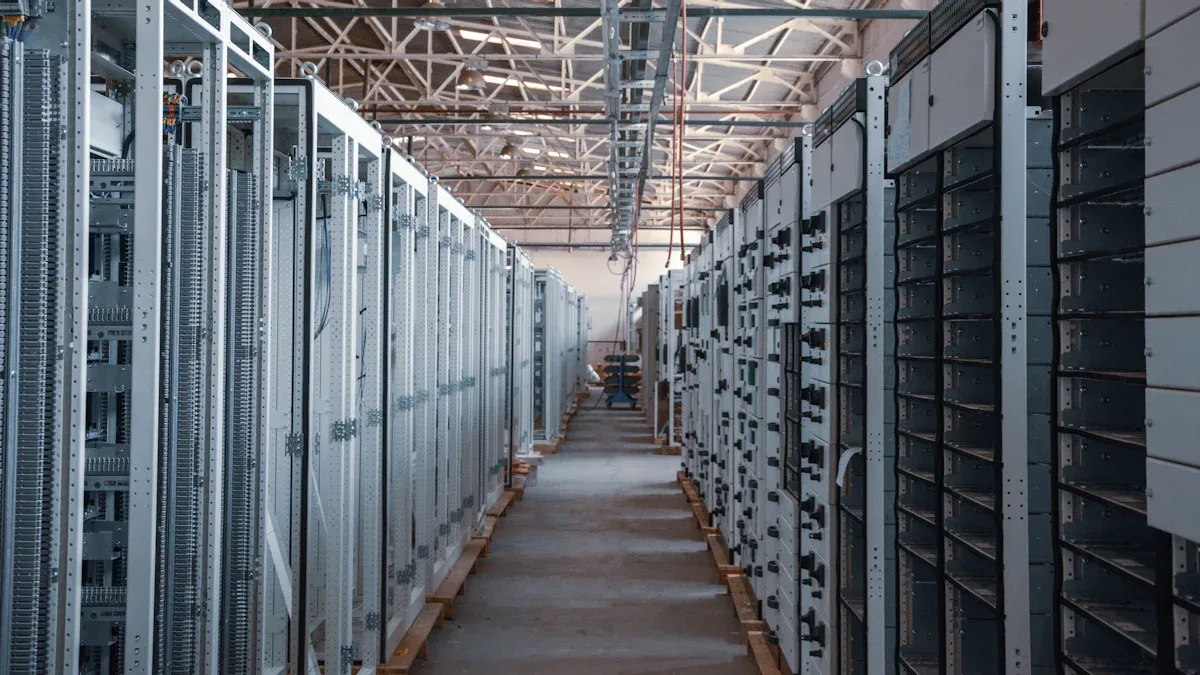
When you set up your center, you want to use every inch of space wisely. Vertical PDUs, also called zero U PDUs, mount along the side posts of your server rack. This method saves valuable rack units for your IT equipment. You do not lose any U-space, so you can fit more servers or storage devices in the same rack. Most racks follow EIA/ECA-310-E standards, but you should check your enclosure depth and side panel design before you determine pdu mounting. Many racks and PDUs use special brackets, so always make sure your vertical PDU matches your rack. Toolless mounting brackets are common and snap into place quickly. Sometimes, you may need to remove side panels if space is tight. Vertical mounting also helps keep cables neat and improves airflow, which protects your equipment from overheating.
Tip: Choose a vertical PDU that is compatible with your rack to maximize space and make installation easier.
You need to plan your rack units and height before you install a PDU in your center. Rack units (U) measure vertical space, with 1U equal to 1.75 inches. Standard racks often reach up to 42U. Always plan for more space than you need now. Add at least 25% extra capacity for future growth. Place heavy equipment like servers at the bottom for stability. Leave empty space above heat-producing devices to help with cooling. Allocate space for patch panels and cable management. Think about both horizontal and vertical cable routes. Plan PDU placement early so you can route power cords easily and avoid blocking airflow.
Installation tips: Reserve space for rack-mountable UPS devices and allow room for heat dissipation above them.
Toolless installation makes your job faster and easier. You can mount many vertical PDUs without tools, which saves time and reduces mistakes. Multiple mounting holes let you add cable management accessories like hook-and-loop ties or fiber spools. Smooth plastic fingers protect cables and keep them organized. Some cable managers ship fully assembled, so you spend less time setting up. Dual-hinged doors and spring-release clips give you quick access for maintenance. Good cable management keeps cables aligned, improves airflow, and lowers the risk of overheating in your center.
Installation tips: Use cable tie-downs and divider plates to keep cables neat and make future changes simple.
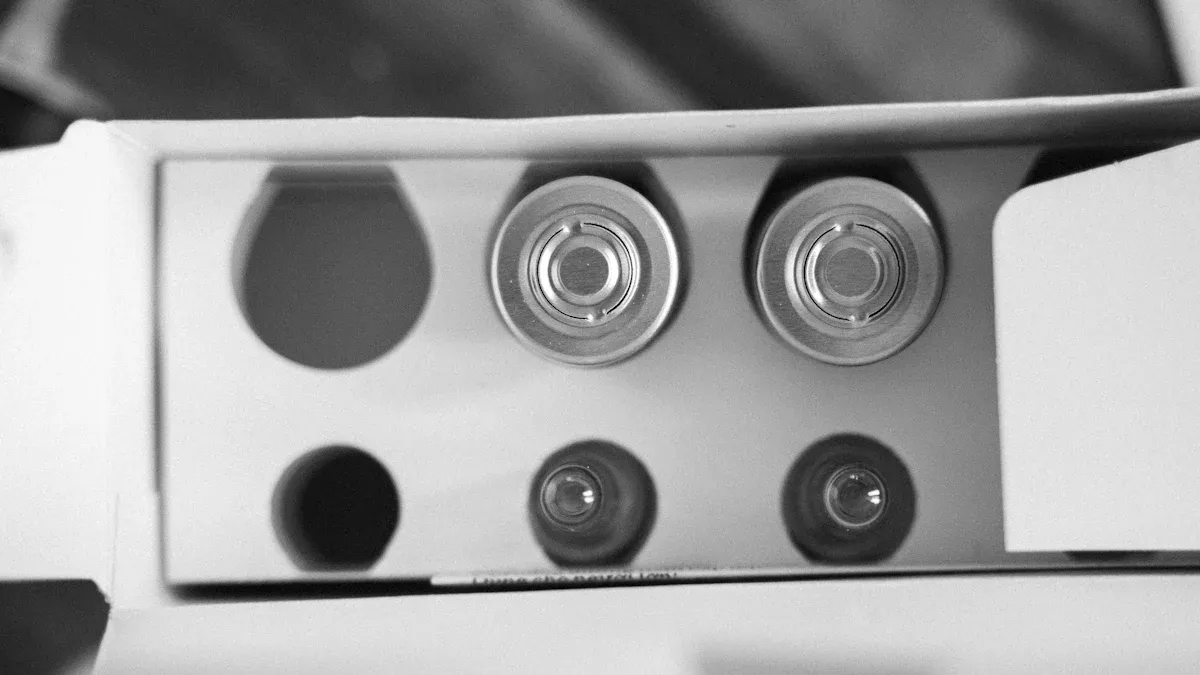
You will find that most vertical rack PDUs use IEC 60320 C13 and C19 outlets. These outlets support a wide range of IT equipment, such as servers, switches, and storage devices. C13 outlets fit devices with lower power needs, while C19 outlets handle higher power equipment. Many rack power distribution unit models combine both types to give you flexibility.
Here is a table showing how leading PDUs use these outlets:
| PDU Model | Outlet Types and Quantity | Compatibility and Features |
|---|---|---|
| APC NetShelter Metered Rack PDU | 36 IEC 60320 C13, 6 IEC 60320 C19 | Designed to power servers, switches, and network devices; locking IEC receptacles reduce accidental disconnections |
| HPE G2 Basic Vertical PDU | 36 C13, 12 C19 | Compatible with typical IT equipment power cords; optional dual-locking cords for secure connections |
| Generic Vertical PDU (Server-Rack-Online) | Combination of C13 and C19 outlets (48 total) | Supports a variety of IT equipment power needs in racks |
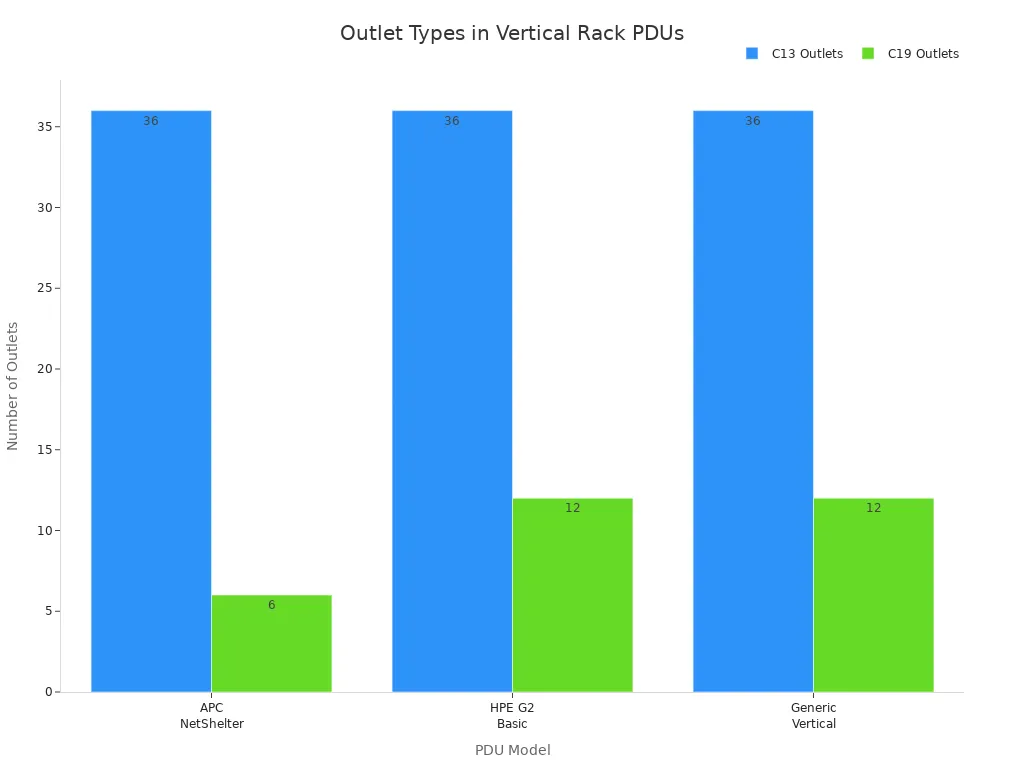
You should always check your equipment’s plug type before choosing a PDU. This step ensures safe and efficient distribution.
You need to plan the number of outlets based on your current and future equipment. Start by listing all devices you want to power. Check each device’s power rating. Add up the total power load. Always select a PDU with more outlets than you need right now. This gives you room for growth.
Follow these steps to determine the right outlet arrangement:
Proper planning helps you avoid overloads and supports reliable distribution. You also make cable management easier when you arrange outlets to match your rack layout.
Tip: Place two vertical PDUs on opposite sides of the rack for better distribution and redundancy.
Outlet orientation affects how easy it is to connect and manage your devices. Vertical PDUs often have outlets facing sideways or at an angle. This design helps you plug in many devices without blocking airflow. You should look for PDUs with clear labeling and enough space between outlets. This makes it easier to connect large plugs or adapters.
Think about accessibility when you plan your rack. Place heavy equipment at the bottom and leave enough space for cables. Use cable management tools to keep cords neat. Good outlet orientation and accessibility help you maintain safe and efficient distribution in your data center.
You can improve power management in your data center by using remote monitoring and control features. These tools let you track power consumption in real time at both the PDU and outlet levels. You can prevent overloads by watching input metering from anywhere. If you find underused devices, you can power them down to save energy. Remote alerts help you respond quickly to problems, which keeps your systems safe. You can also use these features to plan for future needs and balance your power loads. Remote monitoring supports automation and smarter energy management, which helps you reduce waste and extend equipment life.
Modern vertical rack PDUs often include environmental sensors. These sensors give you important data about your rack’s conditions. You can track temperature, humidity, airflow, air pressure, water leaks, dust, vibration, and door position. This data helps you spot hot spots and optimize cooling. You can prevent downtime by acting on alerts from these sensors. Many PDUs connect with data center management systems, so you can see all your monitoring data in one place. This integration makes it easier to keep your equipment safe and your power management efficient.
Tip: Use environmental sensors to maintain the best conditions for your equipment and avoid costly outages.
Surge protection is a key feature in vertical rack PDUs. Surges can come from lightning, power grid changes, or faulty wiring. Surge protectors clamp voltage spikes and send extra energy safely to the ground. This action protects your sensitive equipment from damage. You should use a layered surge protection strategy, placing devices at entry points and near your racks. Circuit breakers add another layer of protection. They trip quickly during faults or overloads, stopping damage before it spreads. Redundancy in your power management setup means you have backup systems ready. This approach keeps your data safe and your center running, even if one part fails.
Note: Good surge protection and circuit breakers work together to lower the risk of equipment damage and downtime.
You need to keep your data center equipment safe from unauthorized access and tampering. Physical security for vertical rack PDUs starts with strong barriers and smart access controls. Many modern racks use lockable doors and reinforced steel frames. These features help stop unwanted entry and protect your valuable devices.
You can add more layers of security by choosing PDUs and racks with tamper-resistant designs. These designs use special panels and hinges that make it hard for someone to break in or remove parts. Some racks also have shatterproof glass doors and extra locking mechanisms. These features work well in sensitive or remote locations.
Access control systems give you even more control. You can use smart locks with RFID cards, biometric scanners, or even your smartphone. These systems let only approved people open the rack. Some setups log every access attempt, so you always know who entered and when.
Environmental sensors and monitoring systems help you watch over your equipment. These sensors track temperature, movement, and other changes. If someone tries to open a door or move a panel, the system can send you an alert right away. Surveillance cameras add another layer by recording video for real-time or later review.
Here are some common physical security features for vertical rack PDUs:
Tip: Combine several security features for the best results. A strong physical barrier, smart access control, and real-time monitoring work together to keep your data center safe.
When you choose a vertical rack PDU, you should look at the warranty and support services. Leading brands offer clear warranty periods and options for extension. For example, APC provides a 3-year limited warranty with the choice to extend for 1 or 2 more years. Black Box gives a standard 1-year warranty, which you can extend up to 3 years for a small fee. These companies also offer services like on-site repairs, annual inspections, and fast response through their partners. You get peace of mind knowing that help is available if you need it.
| Manufacturer | Warranty Period | Warranty Extension Options | Support Services |
|---|---|---|---|
| APC | 3-year limited | 1 or 2 years extension | On-site repairs, inspections, remote management |
| Black Box | 1 year standard | Up to 3 years extension | Free repair/replacement, 30-day return policy |
Tip: Always check the warranty details and support services before you buy a PDU. Good support helps you solve problems quickly and keeps your power management reliable.
You want a brand with a strong reputation and proven experience. Brands like NBYOSUN, APC, and Eaton score high in user ratings and customer support. NBYOSUN stands out with a 4.7 out of 5 rating. Customers praise its advanced technology, flexible installation, and strong support. NBYOSUN holds certifications like ISO9001, UL, and CE, showing its commitment to safety and quality. Major companies such as China Mobile and Lenovo trust NBYOSUN for their data centers. Users report up to 15% energy savings and a 20% improvement in uptime with NBYOSUN PDUs.
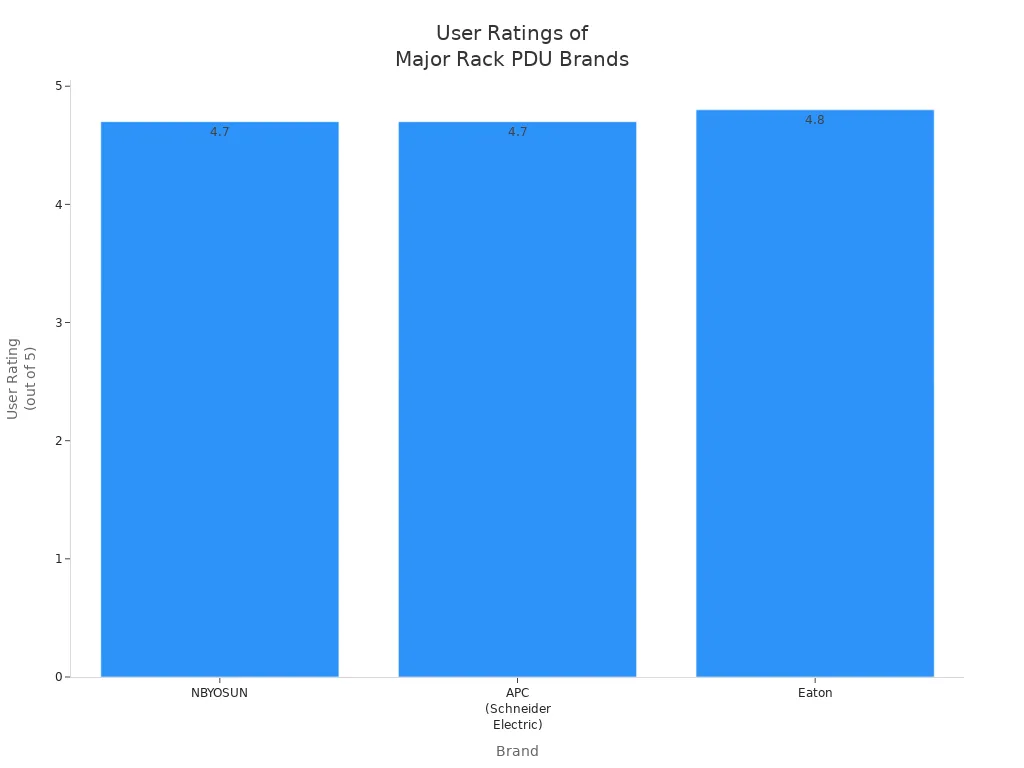
You should also look for brands that test their PDUs in tough conditions. Real-world testing for heat, vibration, and moisture proves that the product will last. Brands that share their test results and certifications give you more confidence in your power management choices.
Every data center has unique needs. Standard PDUs may not fit special workloads like AI, HPC, or edge computing. You can choose custom PDUs to match your power management goals. Custom options include special outlet types, input cords, and mounting styles. You can also get features like multi-voltage transformers, isolated designs for multi-tenant centers, and advanced monitoring tools. These options help you plan power distribution, manage environmental conditions, and support high-density racks.
Custom solutions help you save money, improve reliability, and adapt to changing power management needs. You get a PDU that fits your data center perfectly and supports future growth.
You now have a clear checklist for choosing the right vertical rack PDU for your center. Use this guide to make smart decisions and keep your center running smoothly. Each step helps you support uptime and safety in your center. When you plan ahead, your center stays ready for new technology and growth. Remember, the right power distribution unit gives your center the reliability and scalability it needs.
A vertical rack PDU is a power distribution unit that mounts vertically inside your server rack. You use it to supply power to multiple devices, such as servers and switches, while saving valuable rack space.
Check your equipment’s power cords. Most servers use C13 or C19 outlets. Match the PDU outlet type to your devices. If you have mixed equipment, select a PDU with both C13 and C19 outlets for flexibility.
Remote monitoring lets you track power usage and receive alerts from anywhere. You can spot problems early, prevent overloads, and manage your data center more efficiently. This feature helps you keep your equipment safe and your center running smoothly.
Yes, many vertical rack PDUs support toolless installation. You can use snap-in brackets or clips to mount the PDU quickly. This method saves time and makes future changes easier.
Key Reasons Why Auto Transfer Switch PDUs Are Vital
Important Advantages Of Auto Transfer Switch PDUs To Know
A Professional And Leading Manufacturer
For OEM
& ODM Power Distribution Unit (PDU)
You Can Trust
CONTACT
Ningbo YOSUN Electric Technology Co., LTD
Leading Professional Manufacturer in PDU Power Solutions
Contact Info.